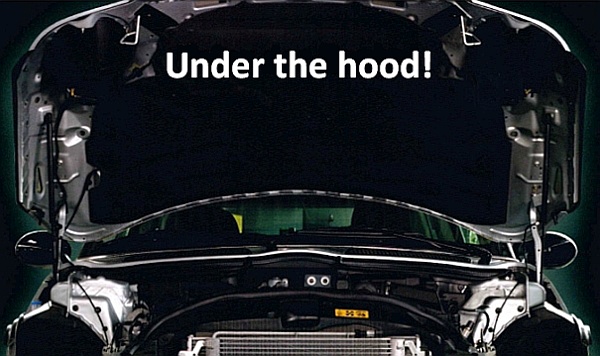Automotive: Reinforcements for sound absorption elements
Car manufacturers use sound absorption elements for the noise reduction of their vehicles. These elements are mostly made of heavy foamed plastics / polyurethane (PUR) hard foam, bitumen or composite materials.
They are typically assembled or applied in spaces which allow merely an extremely flat construction, such as underneath the hood / bonnet or under the headliner. Partially these spaces are only accessible within the mounting process (e.g. between door panel and window glasses rolled / winded down). Dependent from the quality degree of a vehicle, sound absorption elements are also used:
- In the A-, B-, C- and (within station wagons / combi vans) D-pillars
- In trunks lids / boot lids
- In interior surfaces of wings / fenders
- In isolations between dashboard and engine bay / compartment (front engine) or between (back) seats and rear engine
- Between carpet and chassis
- At the transmission tunnel
Highly desired side effects of sound absorption elements are the damping of car body vibrations as well as an isolation against heat and coldness. This makes sound insulation moldings also indispensable for motorhomes and caravans.
For a maximum form stability and durability absorption elements need a structural reinforcement. Automotive – engineers rely on BAFA®-laid scrims to optimize sound-absorbing parts against force effects:
- Deformation
- Shear forces
- Slipping / shifting out of position
- Traction
- Friction / abrasion
- Impacts
Reinforcements for rear shelves, headliners, impact protection
BAFA®-laid scrims are also used to reinforce headliners and rear shelves. Here the emphasis lies in increasing the form stability and torsional rigidity. Another area of application are impact protection mats to protect car doors in narrow garages.
What are laid scrims?
Laid scrims are lightweight structures made of yarns /technical textiles that differ significantly from ordinary fabrics:
- The threads don’t lie loosely upon and underneath each other. With a „binder“ they are glued permanently at their contact points.
- Threads run diagonally / multi-axial in 6 to 10 directions. Thus they absorb working forces significantly more effective.
- They are more flexible and simultaneously more stable.
- Their higher structural tearing strength allows wider meshes and a significantly lower weight per unit area.
- You can combine various options of materials, taking benefit of their specific characteristics.
- The threads of the scrim can be equipped with a multitude of impregnations to support the specific purposes of the final product.
For more information about BAFA®-laid scrims click here.
Suitability for automated production processes
Every second of a vehicle’s mounting process costs money. With BAFA®-laid scrims the suppliers of the automotive industry save time in the assembly of their products. You have 3 options to process our laid scrims:
- As a layer within multi-layer products
- Gluing on contact surfaces (e.g. body panels)
- As an element of double-faced adhesive tapes
BAFATEX supplies laid scrims in coiled widths – on request just-in-time. With their excellent cuttability and punchability they enable a high build quality and a high processing speed. Thus they are suitable for manual workmanship as well as for automated punching production lines.
Material options
Depending in which characteristics your product shall have we offer you laid scrims of these materials:
- Polyester
- Polyamid
- Viscose
- Aramid
- Glass fibre
- Carbon fibre
- Kevlar
- Bekitex
- Twaron
- Nomex
- Technora
- Steel filament mixed yarns
- Jute
- Cotton
- Flax
- Sisal
- more materials on request
Glass fibre / glass filament is the most widely used material to reinforce sound absorption elements in the automotive industry. Glass fibre / glass filament is particularly resistant against the heat of engines and very low outdoor temperatures, with an impressive durability under extreme variations in temperature.
The typical specification for reinforcements of sound absorption elements:
- Glass filament yarn
- 6-directional,
- Warp / longitudinal direction: 34 tex,
- Weft / cross direction: 22 tex
Technical data
Please take a look at the data about tenacity, breaking load and elongation of:
Individual configuration
You can meet your demands and reinforce your products by altering multiple variables:
- Material, combination of materials and their characteristics (e.g. soft, hard, heat-sealable, waterproof, flame retardant)
- Thickness of the threads
- Width of the mesh
- Elongation (1,7 – 23%)
- Breaking load (2,2 – 448 N)
- Tenacity (13 – 355 cN/tex)
- Angles (and hence force transmission) of crossing threads
- Colors
- Impregnators (Prepregs)
Know-how and consulting
Based on our experience of decades and our technical expertise we would be pleased to consult you about the range of characteristics and processing technologies of our scrims.
As a matter of course we are certified by DIN ISO 9002 (since 1994) to assure a permanent and high quality of our products.
Technical literature: Automotive acoustics and noise reduction
As technical literature for engineers we recommend:
- David A. Bies, Colin H. Hansen : “Engineering Noise Control: Theory and Practice, Fourth Edition”
- George Kellie: “Advances in Technical Nonwovens (Woodhead Publishing Series in Textiles)”
- Gang Sheng: “Vehicle Noise, Vibration, and Sound Quality”
- M. L. Munjal: “Noise and Vibration Control: (IIsc Lecture Notes Series – Vol 3)”
Header Image: Porsche 911 length cut: Maximilian Schönherr, Creative Commons



